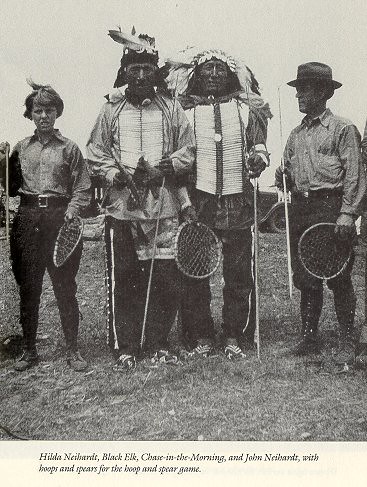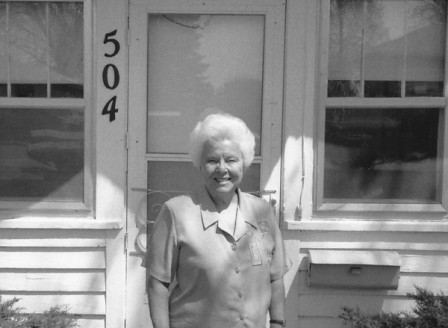What happened to me on that blustery afternoon fifteen years ago cannot be explained.
Four hundred miles from home. Bancroft, Nebraska. The area formerly inhabited by the Omaha Indians is now this small town of fewer than five hundred. Ninety-eight percent of European descent.
I am ready to meet Hilda Neihardt, the author of Black Elk and Flaming Rainbow, which chronicles the more personal experiences during her father, John Neihardt’s, famous interviews with Oglala Sioux holy man, Black Elk. I can’t help but think about how those interviews started on this same afternoon–the ninth of May, sixty-six years ago.
In 1931, tomboy-ish and spirited, often wearing breeches and boots at her Ozark home, Hilda misses the last two weeks of her freshman year in high school to be the “official observer” on the trip to the Pine Ridge Reservation to hear Black Elk’s story. With her father and older sister, she sleeps in the small log cabin with the holy man’s family (only a blanket divides them) until they are given a teepee. Feeling a kinship with John Neihardt, Black Elk names him Flaming Rainbow, and then tells him the vision he received as a young boy from the thunder beings. Black Elk’s son translates, Hilda’s older sister takes notes, and John Neihardt composes the manuscript of the medicine man’s words, which becomes Black Elk Speaks.
Hilda rides horses with young Sioux men and serves often as camp cook. She listens intently to the visions of a man who, as a boy, was tender and restless like herself. For Hilda’s curious mind, Black Elk names her Daybreak Star Woman—very fitting given her childhood ways of rising early to eavesdrop on her artistic, intriguing parents. Though Black Elk’s vision was specifically for his Lakota Sioux people, Hilda would carry more than one of Black Elk’s messages into old age. While walking near home, Daybreak Star Woman would see the world as a sacred hoop where all beings live inside.
At the Neihardt Center, dedicated to her father’s studies, I take my time in the sacred hoop garden which represents a part of Black Elk’s vision Neihardt viewed as universal. In the center of the garden is the tree of a life, at the juncture of two colored paths: the black road of earthly difficulties and the red road of spiritual awareness. This intersection is where human beings dwell, and our lives are holy. The flowering crab tree, a third the size it is today, has started to bud an eye-popping pink.
I leave the garden and find Hilda in the rotunda of the main building. A strong, sturdy woman of eighty years, she has short white hair and shoots me a nice smile, but my face breaks into an anxious grin when we shake hands. To be connected to living history, I have travelled a great distance. I wonder if I have not also travelled across years spanning not only my life and hers, but her father’s and Black Elk’s, too.
Hilda, still the tomboy, pops briskly through the door at the Country Pub on Fourth and Main in this town where she was born and has returned. Drawn shades darken the bar at lunchtime. Hilda and I sink into cafeteria chairs at a square brown table. She talks about people who are not Native Americans.
“They think they are separate from things, Dave. They think they are separate from animals. From nature. But like you and I, they are not separate at all.” And she smiles.
Hilda entertains me with stories when highways were gravel and when she rode horseback with Leo Looks Twice. How free she felt. Black Elk was a sweet and generous man. “I came home a changed person, ” she tells me.
I hunch over the brown table. Our plates and iced tea pushed to the side. We chat a little bit about books I’d recently read, which includes Bury My Heart at Wounded Knee. I talk about my quest for self-understanding, my hanblechyapi, to feel the orenda.
She leans a bit forward. Out of respect for me. And to keep our conversation guarded from the couple at the bar.
“I can see you’re passionate about understanding who you are, who we all are. And what to make of your experiences so far. But whatever you do, don’t play like you’re an Indian. You are brave in seeking to understand your spiritual life. And that is wonderful. Keep that up. You will find the guidance you are looking for.”
An hour later, at her home, she allows me to take her picture. A black and white photo. She is locked in time, in the afternoon sunlight. In comfortable clothes my grandmother might wear.
Full sunshine warms a cool day in May as I head east toward home. In the open jeep, my blue chambray shirt floats like a bed sheet until I pin it beneath my seat belt. The Nebraska plain is bare, soulful, economical. An expanse of the two-lane stretches out like a long limb of cottonwood. The road begins to rise up into a small hill, desolate enough to call it a mesa.
Thunder rumbles. But in the rearview mirror, a sunny day glows on the Plains.
As a very old man, Black Elk climbed up to Harney Peak, South Dakota, the place of his vision at the center of the world, and prayed for the Great Spirit to water the sacred tree, if there was still hope for his people. The thunder beings moved a small cloud across the sky and showered down rain.
A half-minute growl, low and deep like a drum. I look up from my exposed jeep. One gray cloud approaches steadily from the northwest, but even so, I am bathed in sunlight. Then, rain pours down. In awe, I pull over to the side of the road.
To the east, a giant rainbow arcs across the sky. I can see its entirety: from ground to ground.
That afternoon in eastern Nebraska as I drove home, a meteorologist might say a small nimbostratus cloud blew in, and a mild thunderstorm ensued while a young man got drenched in the downpour.
Yet, I had just spent an afternoon with Hilda Neihardt. I knew in the way we know things, the dark cloud was no ordinary cloud, and the thunder beings continued to water the sacred tree.
Top photo by JeremyOK, Creative Commons license via Flickr. Photo of Hilda Neihardt, Black Elk, Chase-in-the-Morning, and John Neihardt is used by permission of the Neihardt Trust. Post and photo of Hilda Neihardt by Dave Malone, author of Seasons in Love.
______________________
- From the Poet: Blue of the Heaps of Beads - November 29, 2018
- “Tiny Machine,” by Dave Malone - October 30, 2015
- The Sacred Tree - August 28, 2012




L. L. Barkat says
I feel like I went with you there, Dave. And back. Beautiful.
And this morning, the wind is moving the trees here, and it is raining.
Maureen Doallas says
The sense of place and its meaning is strong, Dave. Lovely essay.
Tania Runyan says
Beautiful, Dave. I drive through this area every summer. Now I will pay a little more attention.
Donna says
“I knew in the way we know things, the dark cloud was no ordinary cloud, and the thunder beings continued to water the sacred tree.” Love this…it’s powerful. I love how you give space and importance to this – you honor it (does it’s synchronicity demand it? I’m hung up on synchronicity). Knowing and ‘knowing’ are two different things. This is great!
Dave Malone says
Ah…thanks, everyone. I really appeciate it. Donna, and coincidence. Many little things seemed to lead me to Hilda–that and youthful exuberance to just take off on a whim to meet her.
Dave Malone says
Glad I used my spellchecker on the post. I meant, appreciate. !
Monica Sharman says
Wow, Dave, what a journey.
You might be an “official observer” yourself.
Darrelyn Saloom says
I am so thankful you got to meet Hilda and share your experience. I imagine she would be quite pleased with your beautifully-written piece.
Diana Trautwein says
This is just lovely. Feels like you entered what the Celts would call a ‘thin place’ on the trip away from Hilda. And like maybe she lives in one all the time. Thanks for this.
Dave Malone says
Monica, indeed. It’s quite extraordinary to think about Black Elk sharing this very powerful vision he had as a nine-year-old boy–and doing so to Hilda’s father. Darrelyn, me, too! 🙂 Hilda was so very generous to talk with someone she didn’t know at all. So gracious. And beautifully written, thank you—but its flow only exists because of your editing acumen! 🙂 Diana, I really like that notion. Black Elk’s vision is such that at the intersection of the black road of life and the red road of the spirit, here we are holy. In essence, there is no separation between holy (wholly) and being alive. As Jesus likely said, “The kingdom of heaven is within you.” There is nowhere to journey to. Which I like to think about because I hold an Alan Watts/Zen belief that heaven is here on earth–there is no separation between earth and spirit–it is an unnecessary distinction. 🙂
Robin Neihardt says
Thank you for writing down that beautiful remembrance! My Mother would have loved it and would have felt great delight in what you experienced as you left. I knew her not only as a wonderful mother and friend, but a very powerful being filled with the Spirit. When she climbed Harney Peak a few years earlier with friends, she was visited by a small and kindly raincloud as you experienced, very much like the raincloud that visited them on Harney Peak in 1931.
Dave Malone says
Dear Robin,
I’m so pleased you enjoyed it. I feel fortunate that TweetSpeak focused on the theme of rain in August, and so what I had hoped to write later this year, suddenly was ripe to write. (Thanks Laura and Will!).
That experience has stayed with me all this time, and for a long time, I’ve wanted to share it. After it happened, I don’t recall telling anyone, except perhaps my roommate, but in conversation, it’s hard to talk about what cannot be explained by…science? Something that is mystical, and yes, of the Spirit. Thank you so much for sharing this…it warms me to think of that—that it happened again.